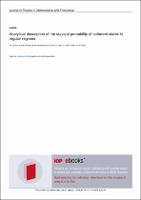Please use this identifier to cite or link to this item:
https://hdl.handle.net/20.500.12202/4294Full metadata record
| DC Field | Value | Language |
|---|---|---|
| dc.contributor.author | Lerma-Hernandez, Sergio | |
| dc.contributor.author | Chavez-Carlos, Jorge | |
| dc.contributor.author | Bastarrachea-Magnani, Miguel A. | |
| dc.contributor.author | Santos, Lea F. | |
| dc.contributor.author | Hirsch, Jorge G. | |
| dc.date.accessioned | 2018-12-31T20:17:36Z | |
| dc.date.available | 2018-12-31T20:17:36Z | |
| dc.date.issued | 2018 | |
| dc.identifier.citation | Santos, L.F., Lerma-Hernandez, S., Chavez-Carlos, J., Bastarrachea-Magnani, M.A., and Hirsch, J.G. (2018). Analytical description of the survival probability of coherent states in regular regimes. Journal of Physics A: Mathematical and Theoretical 51(47): 475302. | en_US |
| dc.identifier.issn | 1751-8113 | |
| dc.identifier.uri | https://doi.org/10.1088/1751-8121/aae2c3 | en_US |
| dc.identifier.uri | https://hdl.handle.net/20.500.12202/4294 | |
| dc.description.abstract | Using coherent states as initial states, we investigate the quantum dynamics of the Lipkin–Meshkov–Glick (LMG) and Dicke models in the semi-classical limit. They are representative models of bounded systems with one- and two-degrees of freedom, respectively. The first model is integrable, while the second one has both regular and chaotic regimes. Our analysis is based on the survival probability. Within the regular regime, the energy distribution of the initial coherent states consists of quasi-harmonic sub-sequences of energies with Gaussian weights. This allows for the derivation of analytical expressions that accurately describe the entire evolution of the survival probability, from t = 0 to the saturation of the dynamics. The evolution shows decaying oscillations with a rate that depends on the anharmonicity of the spectrum and, in the case of the Dicke model, on interference terms coming from the simultaneous excitation of its two-degrees of freedom. As we move away from the regular regime, the complexity of the survival probability is shown to be closely connected with the properties of the corresponding classical phase space. Our approach has broad applicability, since its central assumptions are not particular of the studied models. | en_US |
| dc.description.sponsorship | We acknowledge financial support from Mexican CONACyT project CB2015-01/255702, DGAPA-UNAM project IN109417 and RedTC. MABM is a post-doctoral fellow of CONACyT. SL-H acknowledges financial support from the CONACyT fellowship program for sabbatical leaves. LFS is supported by the NSF grant No. DMR-1603418. | en_US |
| dc.language.iso | en_US | en_US |
| dc.publisher | American Physical Society | en_US |
| dc.relation.ispartofseries | Journal of Physics A: Mathematical and Theoretical;51 | |
| dc.rights | Attribution-NonCommercial-NoDerivs 3.0 United States | * |
| dc.rights.uri | http://creativecommons.org/licenses/by-nc-nd/3.0/us/ | * |
| dc.subject | survival probability | en_US |
| dc.subject | coherent states | en_US |
| dc.title | Analytical description of the survival probability of coherent states in regular regimes. | en_US |
| dc.type | Article | en_US |
| dc.contributor.orcid | 0000-0001-9400-2709 | |
| local.yu.facultypage | https://www.yu.edu/faculty/pages/santos-lea | |
| Appears in Collections: | Stern College for Women -- Faculty Publications | |
Files in This Item:
| File | Description | Size | Format | |
|---|---|---|---|---|
| Santos Lerma-Hernández_2018_J._Phys._A__Math._Theor._51_475302.pdf | OA | 1.74 MB | Adobe PDF |  View/Open |
This item is licensed under a Creative Commons License

